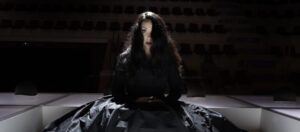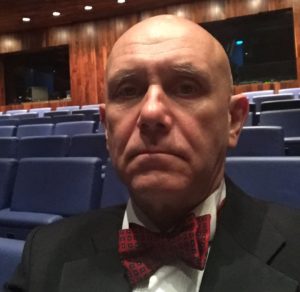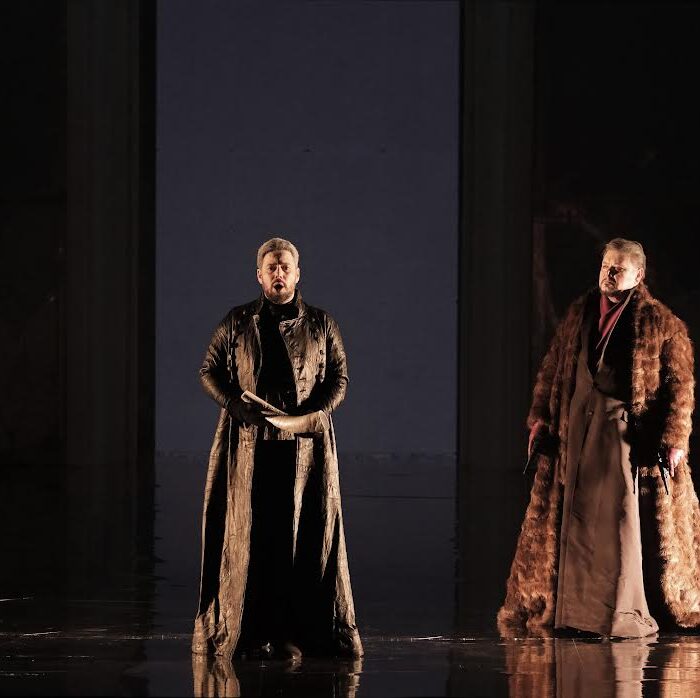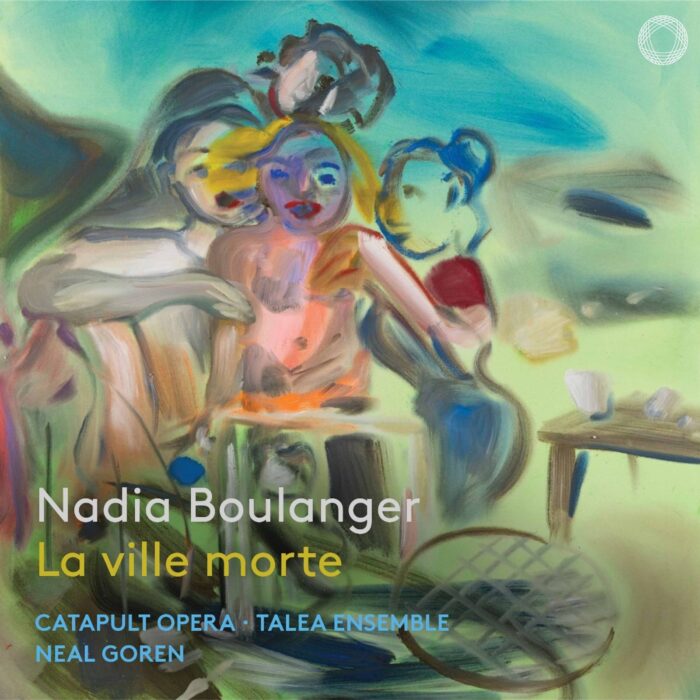
Rossini Opera Festival 2025 Review: Zelmira
Anastasia Bartoli Standout Performance In Bieito’s Insightful Staging
By Alan Neilson(Photo: Amati Bacciardi)
In 1822, Rossini’s opera “Zelmira” premiered at Naples’ Teatro San Carlo to widespread acclaim and was quickly taken up by theaters across Europe, including Vienna, London and Paris. However, like most of the composer’s works, it quickly fell by the wayside and had to wait for over 100 years to be revived, with a performance in 1965 at the San Carlo, although this time its reception was lukewarm. Further performances have since taken place but have done little to bring about a fundamental change in its fortunes. With its dramatically powerful music, compelling melodies, complex harmonies and ensembles that allow for brilliant vocal displays from the singers, it certainly cannot be Rossini’s score that is the problem, as can be confirmed by recent recordings.
The fault may lie with the libretto with its long backstory, which is essential for a full understanding of the drama of what is a convoluted and not always convincing narrative.
The opera is set on the peaceful isle of Lesbos, which is ruled over by King Polidoro. His daughter, Zelmira, is married to Ilo, who happens to be away on a military campaign. The king of Mitylene, Azorre, who is seething at being rejected as a husband for Zelmira, takes the opportunity to invade the island, intending to kill Polidoro and take the throne. Taking no chances, Polidoro hides in the crypt among the tombs of the kings of Lesbos, while Zelmira informs Azorre that he has taken refuge in the Temple of Ceres, which Azorre orders to be burnt to the ground, believing that Polidoro will be killed in the fire. Unfortunately, a short time later, Atenore, who wants to be king of both Lesbos and Mitylene, kills Azorre, aided by Leucippo. The opera has yet to begin, but a complex web of relationships, themes and motivations has already been brought into existence, which will play out over its course.
Controversial Brilliance from Bieito
The controversial director, Calixto Bieito, who was charged with bringing this production by the Rossini Opera Festival to the stage, identified its main drivers as related in its backstory as violence and threat of violence, the desire for power, the personal motivations of the powerful and those seeking power that are able to plunge whole societies into war, how the lack of meaningful connections between peoples exacerbates the tendency towards conflict, and how the past weighs upon the present, entrapping the whole populace.
The narrative, which takes place over the course of two acts, is no more than the superficial specifics of the underlying motivations. We watch as Zelmira struggles to save her father and alienates her husband, Ilo, who believes she is guilty of betraying him, her family and her country, and how Atenore scrambles to take and hold on to the throne before Ilo eventually discovers the truth and rallies to save the day. The actual events were not really that important to Bieito, who did not even find it necessary to provide program notes explaining his interpretation nor surtitles for the audience to follow the drama; it was the process, the drivers and the consequences that mattered, which he revealed through layers of imaginative, thought-provoking symbols and symbolic actions, the meaning of which was not always clear but always managed to convey the thrust of the idea, at least on a subconscious level. It was a brilliant presentation, even if not to everyone’s liking.
The performance took place in the Scavolini Auditorium, a large sports hall in the centre of Pesaro. The stage was positioned in the middle, surrounded on all four sides by raised seating. It was an enormous area; the fact that the orchestra pit, situated in the middle of the stage, appeared fairly small may provide an idea as to how big the performance area actually was. The chorus took a variety of positions, although not on the stage itself; they appeared on the floor of the auditorium, at the sides of the stage, and even in the aisles of the seating areas. Visually, it was a performance on a vast scale! The large stage meant that the singers could be thirty meters or more apart, and, at times, they did not even face each other but looked outwards towards different sections of the audiences, reinforcing the lack of connection between the characters.
The staging, designed by Bieito and Barbora Horáková, consisted of a floor made of perspex squares that were able to light up in various colors. In each corner, there was a sunken pit, each with its own specific symbolic meaning. At the beginning of the opera, Azzore’s dead body lies in one of the pits; he might be dead, but his presence still held sway. Leucippo, therefore, drags him out, zips him into a body bag and places him in another pit, with the intention of using his murder as a rallying point to invade Lesbos. Unfortunately, such actions rarely achieve their desired goals, and later in the act, Azzore unzips the body bag, crawls out of the pit and inserts himself into the drama, bringing with him a further wave of threats and violence and destabilizing Atenore’s position.
Another pit was full of water, which Atenore and Leucippo used to wash the blood from their hands and possibly attempt to cleanse themselves of their sin.
During Act two, the stage fractures and divides into two parts, widening the distance between the characters even further.
Props were kept to a minimum; for most of the performance, the stage remained more or less empty. The props that were used were rarely for decorative purposes but used to draw attention to the struggle for power and the violence that thereby ensues. In Act two, a throne was positioned at the end of the stage, and everyone, including Zelmira’s child, seemed determined to sit upon it, all apart from Zelmira, who notably kept her distance. In Act one, soldiers’ helmets lay strewn across the stage, which were collected and piled up in an acknowledgement of the many dead that are the real consequences of war. In Act two, the helmets are transformed into a monument as a testimony to the glory and real cost of a power struggle.
Ingo Krügler, responsible for costume design, did not opt for an aesthetic associated with a specific period, and there was no connection with the classical era. Most costumes were dark in color, highlighting the nature of the piece.
There were a lot more symbolic references along the way; some were clear, some needed careful deciphering, while others were simply opaque, such as Emma, Zelmira’s friend, who at one point finds herself entangled in reels of videotape – maybe it was something to do with memory. Yet, such was the strength of the production that such difficulties did not detract from a fundamental understanding; it was always possible to connect with the interpretation, even if not always on a rational, conscious level. One theme, however, that did shine through, and which was presented with clarity, was how power struggles, involving only three or four privileged people, are able to translate into widespread turmoil and death among the wider population.
It proved to be a perfect example of a Bieito production. It was insightful, gripping and provocative but, as is not unusual for one of his stagings, annoyed as many people as it delighted. By contrast, the musical side of the performance was a complete success. It is difficult to imagine anyone leaving the theatre with any reservations at all.
Sagripanti Oversees a Magical Musical Performance
The conductor, Giacomo Sagripanti, oversaw a quite brilliant performance from the Orchestra del Teatro Comunale di Bologna that captured both the dark atmospheric and taut emotional strengths of the piece, in which their playing possessed a vibrant clarity that carried the drama and a sensitivity that highlighted the score’s layered textural qualities. His handling of the balance between the singers and the orchestra was masterful, especially given the fact that he often had his back to the singers, who could be positioned anywhere within a 360-degree orbit, and during the ensembles, in which they could be standing on diametrically opposed sides of the stage.
The soprano Anastasia Bartoli must now surely be counted as one of the festival’s established stars. In the past two years, she has wowed audiences at Pesaro with her portrayals of Cristina in “Eduardo e Cristina” in 2023 and as Ermione in 2024. This year, she produced yet another stunning performance, this time in the role of Zelmira.
One of the qualities that makes listening to Bartoli such a pleasure is that no matter how difficult the vocal requirements of the role, there is never a sense of anxiety or pressure in the voice, a trait that cannot be underestimated, as it allows one to sit back and simply enjoy her performance, confident that nothing is going to interrupt the experience. Of course, there is far more to her singing: the ease with which she is able to project and moderate the voice, her ability to blend with other singers in the ensembles, the freedom and versatility she displays in moulding the line, her seamless passaggio, the clarity of her top notes, the wonderful contrasts, delightful phrasing and precision and control of her delivery are all present, which she uses intelligently to express the emotional, dramatic and psychological dimensions of her character.
Her vocal performance as Zelmira was an absolute delight, in which she successfully developed a sensitive and believable characterization while brilliantly capturing the excitement and beauty of the melodies. Her physical portrayal, however, was less convincing, although this was due more to Bieito’s directorial decisions. Zelmira is a loving, loyal woman, dedicated to her father, husband and son, yet there was very little sign of this; often her position on stage was distant from her family, and when up close there was very little contact. Her attitude to her son, in particular, was very cold.
Tenor Lawrence Brownlee, dressed as an American G.I. just back from the war, played Ilo as, at times, a naïve and slightly unstable hero, maybe suffering from the trauma of battle, but with a good heart and a courageous nature.
There was so much to enjoy about his singing. In Act one, scene five, for example, he made his first entrance, accompanied by his army, and sang the cavatina “Terra amica, ove respira,” accompanied by the male chorus, in which he immediately showed off his lyrical beauty, replete with wonderfully controlled leaps, vocal flexibility and beautifully placed inflections, delivered with confidence and elan, for which he deservedly received thunderous applause. It was undoubtedly one of the many high points of the evening. In Act two, he displayed his fine ensemble singing in the duet “In estasi di goia” with Polidoro, in which the flexibility of two voices complemented each other beautifully.
Tenor Enea Scala is an expert in playing the role of a psychopath; he must have a catalogue of variations at his disposal, which he can dip into as needed. As Antenore, he opted for a particularly animated, crazy version, in which he not only exuded an evil, vicious intent but also showed little desire to control its expression. He came across as damaged, deranged and dangerous. His aria “Mentre qual fera ingorda” was delivered while lying upside down on the throne, with his legs pointing upwards. When working in tandem with Leucippo, the pair appeared like a couple of thugs, more at home in a street brawl than involved in power politics. It was expressively and emotionally a rollercoaster of a ride, which Scala’s vocal interpretation brilliantly complemented. He possesses the ability to coat the voice with emotional strength and nuance, particularly of the negative variety, such as menace and aggression, and is able to inflect the vocal line with color and reinforcing accents. His singing is always secure, confident and well-projected and can hold the line with ease.
Mezzo-soprano Marina Viotti, playing the role of Zelmira’s confidante and friend, Emma, made an excellent impression. The part was given more significance than related in the libretto, in that her relationship with Zelmira’s son is expanded and deepened. Whereas Zelmira remained physically and emotionally distant from the boy, Emma was continually focused on his wellbeing, which became a point of conflict between the two women and made her initial suspicion and mistrust of Zelmira more understandable. It proved to be an imaginative and dramatically sound decision, unlike another of Bieito’s interventions that had the two women involved in an intimate affair; there was no obvious reason for this other than the opera takes place on the isle of Lesbos, and it added nothing to the drama.
Viotti created a physically compelling portrait, but it was her brilliant vocal characterization underpinned by her secure technique, attractive timbre and neatly crafted phrasing that caught the attention, which she expertly displayed in her aria, “Ciel pietosa, ciel clemente,” with a powerfully expressive rendition, in which she successfully captured her worries about the boy’s safety, employing her versatile coloratura to reflect her anxiety.
Bass-baritone Marko Mimica created a sensitive, sympathetic portrayal of the aging King Polidoro, who wanders the stage fighting for survival and the retention of his power. He appeared frail. At one point, he finds himself crawling around in one of the pits, possibly a pit of despair, bemoaning his situation. He possesses a resonant, well-supported voice, which he crafted successfully to carry the meaning of the text.
Bass-baritone Gianluca Margheri played Leucippo as a menacing, emotionally cold and vicious character, prone to intense outbursts; for him, dragging Azorre’s corpse around the stage was just part of a normal day’s work. He was also portrayed as Antenore’s lover, which, unlike Zelmira and Emma’s relationship, did appear to have a substance to it, as it created a believable erotic tension and added a deeper bond to their relationship, in which their shared sadistic desire for violence and control fed off each other. Margheri produced a convincing vocal interpretation, in which he moulded his voice to capture Leucippo’s threat, although having him remove his shirt at every possible opportunity became somewhat tedious and undermined his characterization.
Tenor Paolo Nevi, although cast in the small role of Eacide, created an interesting impression as he walked up and down the aisles of the auditorium, dressed as an angel with large white wings and a cigarette tucked behind his ear, singing with a swagger in his voice.
Bass Shi Zong, playing the part of Gran Sacerdote, completed the cast. Rather than a religious appearance, he was given a contemporary look, dressed in shorts with lime green hair. He sang confidently, bringing an authoritative air to the role.
The Coro del Teatro Ventidio Basso, under the direction of Maestro Pasquale Veleno, was on splendid form, performing the numerous choruses with an emotional frisson and energy that captured the spirit of the production.
Personally, I found the production to be a success on every level, although one unlikely to be to everyone’s tastes. Bieito managed to shine a light on so many of the underlying and relevant themes that permeate the narrative, which, with his challenging way of exploring and presenting them, made for an interesting and fascinating staging, while musically, it was an experience that will live in the memory.



